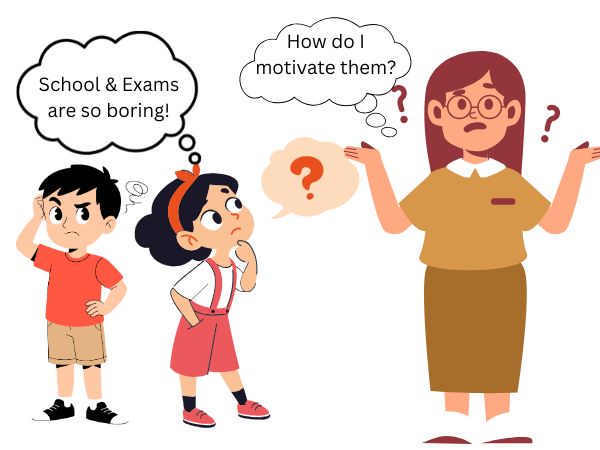It’s October. The excitement of a new term that filled our classrooms in June has started to fade. The Dussehra break has just ended, the mornings are cooler, and the post-festival lull has gently settled over students and teachers alike.
You can sense it — that slight dip in energy. Students walk in cheerfully chatting, but their focus is elsewhere. Teachers, too, feel the tug of fatigue. Lesson plans that once felt fresh now feel routine. Assignments go missing. Some students have already begun saying, “I’ll catch up before the next exam.”
It’s a familiar scene in Indian schools every October — a time when both learners and educators need a motivational reboot.

 The Challenge: When Motivation Fades
The Challenge: When Motivation Fades
In staff rooms across India, one topic never loses relevance:
“Why aren’t students motivated?”
Teachers wonder:
Why does attention drop right after Holidays?
Why do students who show energy on the sports field lose it in class?
Why are some so bright during discussions, yet so passive with homework?
The truth is — motivation is not a constant; it’s a current that flows and fades. And after holidays or exam breaks, that current needs to be reignited — not through punishment, not through rewards alone, but through understanding how the brain finds purpose again.
 Lessons from Brain based teaching
Lessons from Brain based teaching
At Pipal Tree, we approach motivation from a neural and emotional lens. Every behavior — even lack of it — is communication. A disengaged student isn’t lazy; their brain is signaling disconnection, boredom, or a lack of emotional relevance.
American psychologists Edward Deci and Richard Ryan’s Self-Determination Theory (SDT) helps explain this beautifully. They identify three key drivers of intrinsic motivation:
1. Competence – “I can do this.”
2. Relatedness – “I belong here.”
3. Autonomy – “I have a choice.”
When these needs are met, students want to learn — not because of marks, but because the learning feels meaningful.
 Competence: Help Students Feel “I Can Do This”
Competence: Help Students Feel “I Can Do This”
Classrooms often see students giving up too early — not because they don’t care, but because the challenge feels out of reach.
Ask yourself as a teacher:
- Have I broken this concept into clear, achievable steps?
- Do students feel small wins before big ones?
- Have I reduced unnecessary barriers — unclear instructions, dense worksheets, or overly abstract tasks?
- Am I appreciating effort and growth, not just right answers?

 Relatedness: Create “I Belong Here” Moments
Relatedness: Create “I Belong Here” Moments
Students engage more when they feel seen and valued. Here in this context, this means more than group work — it means connection.
Ask yourself:
- Do my students feel safe to make mistakes without embarrassment?
- Have I connected today’s lesson to their world — maybe a festival, a family tradition, or something from social media they relate to?
- Have I given space for students to express their identity — in their language, culture, or examples they bring to class?
- Am I noticing when someone feels left out — due to language, confidence, or background?
When classrooms feel like communities, learning becomes an act of belonging.
 Autonomy: Give Students the Power of Choice
Autonomy: Give Students the Power of Choice
One of the most underused motivators in Indian schools is choice. Students who are always told what to do rarely learn why they’re doing it.
Consider:
- Can I let students choose their project topic, group, or presentation format?
- Am I using phrases like “you must” or “you can try”?
- Do I explain why a task matters — especially when it seems routine?
- Can students ask their own questions or experiment with their own examples?
When autonomy enters learning, ownership follows — and motivation returns.
 Rekindling the Spark — For Students and Teachers
Rekindling the Spark — For Students and Teachers
Just like students, teachers also need re-ignition. It’s okay to feel weary mid-term. The brain, too, needs novelty and emotional renewal.
So, maybe start your week differently:
- Share a personal festival story that connects to your subject.
- Change classroom seating for a day.
- Ask students, “What’s one thing that made you smile this week?”
- Try a short brain break or movement activity before starting a new concept.
When the teacher’s energy shifts, the class follows. Motivation is contagious.
 Final Thought
Final Thought
Motivation doesn’t live in rewards or punishments — it lives in connection, relevance, and trust.
As educators, our goal is not to force focus but to design for it.
When lessons balance competence, relatedness, and autonomy, students don’t just attend class — they engage with it.
At Pipal Tree, our Brain based teaching approach helps teachers create classrooms where both hearts and minds stay awake.
So, as you plan this week’s lessons, ask yourself:
“Will my students feel capable, connected, and in control?”
If the answer is yes, motivation will take care of itself.
About Pipaltree
Pipal Tree is India’s leading educator development platform, founded by Vishwanathan Jayaraman, focusing on brain-based teaching for last decade and half. With over 50,000 teachers trained and 2 lakh students impacted, Pipal Tree helps schools create classrooms that think, feel, and thrive. Want to book a program or workshop, please feel free to call 9740790822. or Simply send your inquiry through the home page.
